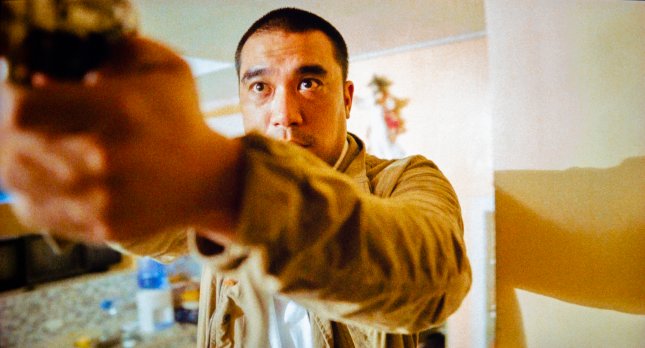Lisa Ito
Keith Deligero’s A Short History of a Few Bad Things (2018), which premiered as part of the Cinema One Originals festival last year, offers several moments that distinguish it from the concurrent line-up of other local murder-mystery thrillers.
The first scenes are enigmatic enough, offering moments that don’t readily align: an underwater scene submerged with whale sharks; a local pawnshop owner is shot in broad daylight, execution-style with a single bullet to the head, at a busy crossing in Cebu City; found, grainy footage of huts burned down during the night, in the year 1998.
The senior investigator tasked to trace the identity of the assassin, an ex-soldier named Felix Tarongoy (Victor Neri), soon finds himself chasing leads that do not also add up, eliding easy answers. Accompanied by rookie colleague Jay Mendoza (Jay Gonzaga) and hounded by the weathered and often exasperated city Chief of Police Ouano (Publio Briones III), Tarongoy finds himself continually outsmarted along the way as witnesses and suspects to the crime are killed in succession. Inexplicably drawn to the widowed Gemma/Maria Calag (Maricel Sombrio) and her farmboy companion Ivan Calag (Kent Divinagracia), Tarongoy defies direct orders and follows a trail that leads back to an exposé and the most unlikely and ironic of encounters.
 (Still photo courtesy of Gale Osorio)
(Still photo courtesy of Gale Osorio)
The terse ties that bind each killing to an incident two decades back are revealed here in due time. The film fascinates in its subdued storytelling, cinematography, and haunting soundtracks and music scores that seamlessly connect points in history. Unanswered queries and ominous signs are left for the viewer to complete and decode, while scenes of the chase and its characters foreshadow a longer history of violence that eventually catches up with those who think they have moved on and away.
Among the cast, Neri’s melancholic and Sombrio’s woeful dispositions complement each other well. There is little in terms of overtly theatrical gestures between the two; instead, close up shots during moments of silence best draw out the psychological tension brewing beneath. Conversely, the motley, veering teasingly close to slapstick, mix of Tarongoy’s colleagues and the trio of implicated characters Arturo Binaohan (Reynaldo Santos), Trifon Abueg (Arnel Mardoquio) and Hector (Felicisimo Alingasan) surfaces a sociological taxonomy: conveying in their mimickry of individuals representing the police, the underworld, and charismatic cults a glimpse of the other shadier ties and institutions that bind Philippine society. The screenplay (Paul Grant) which incorporates dialogue in Cebuano, Tagalog, and English is also noteworthy in its exploration of vernaculars.
The strength of the narrative, however, best lies in its ingenious turn towards self-referentiality as it reaches a conclusion. The search for answers boomerangs back to Tarongoy not in the streets of Cebu but in the secluded forests of Masbate island, where he finds himself the subject of scrutiny as he, again, witnesses a moment of final, fiery reckoning. This last stop in the search closes the circle of investigation, while leaving enough gaps for the viewer to fill in any loose ends. One enters a film within a film: and one story begins where the other one ends.
 (Still photo courtesy of Gale Osorio)
(Still photo courtesy of Gale Osorio)
This easy-going sense of referentiality is where A Short History of a Few Bad Things (2018) succeeds in resonating with the larger occurrences and longer histories of impunity beyond the work itself. Certainly, the fascination and engagement of Philippine cinema with extra-judicial killing (EJK) narratives is unfortunately still going strong ever since 2016, when the death toll from the drug war under Pres. Duterte started to escalate and was documented through the works of photojournalists, filmmakers, and visual artists. The technologies of visual culture appearing as objects and narrative devices within the film’s storyline —the camera, the phone, and the television in particular —also reference their utility as modes of documentation, evidence, and reenactment.
 (Still photo courtesy of Gale Osorio)
(Still photo courtesy of Gale Osorio)
Various intertexts can be read between these and many other local filmic responses to the deaths incurred during the course of both the government’s drug war and counter-insurgency drives. The brutal anti-illegal drug and anti-insurgency campaigns, for instance, have started to intersect in real life through recent developments, such as the issuance of Memorandum Order No. 32 on November 22, 2018 putting the regions of Bicol, Samar, and Negros under heightened army and police presence due to “states of lawlessness”, all leading to a sudden escalation of massacres (especially of peasants), EJKs, political killings, and incidents similar to those portrayed and foreshadowed in the film. That the characters, including Tarongoy, are all eventually implicated in histories of military-instigated incidents ties the narrative closer to contemporary politics.
The real world violence referenced in A Short History of a Few Bad Things, interestingly, underscores such penetration and expansion of impunity out of Manila as a capital to the regions themselves, often hiding in plain sight. The film certainly highlights the tropicality and locality of its setting, further siting this through both language and geography in its shift from urban Cebu to rural Masbate. Connected by water as well as shared histories of trauma as embodied in the tragic figures of Tarongoy and company, these sites of investigation attest to the real atrocity: how state violence is not only national in scope, but also personal, local, and archipelagic in its reach as well.
What kind of redemption is implied in the end? Vigilante vengeance, or justice, whether of the protracted or ironic kind? A sense of ambiguity lingers in the particular trajectory that this proposes. Certainly, killers outside the filmic realm roam still freely up to now. But the film issues an ample warning to all those concerned: the bells will toll not only for those you felled, but also for thee.